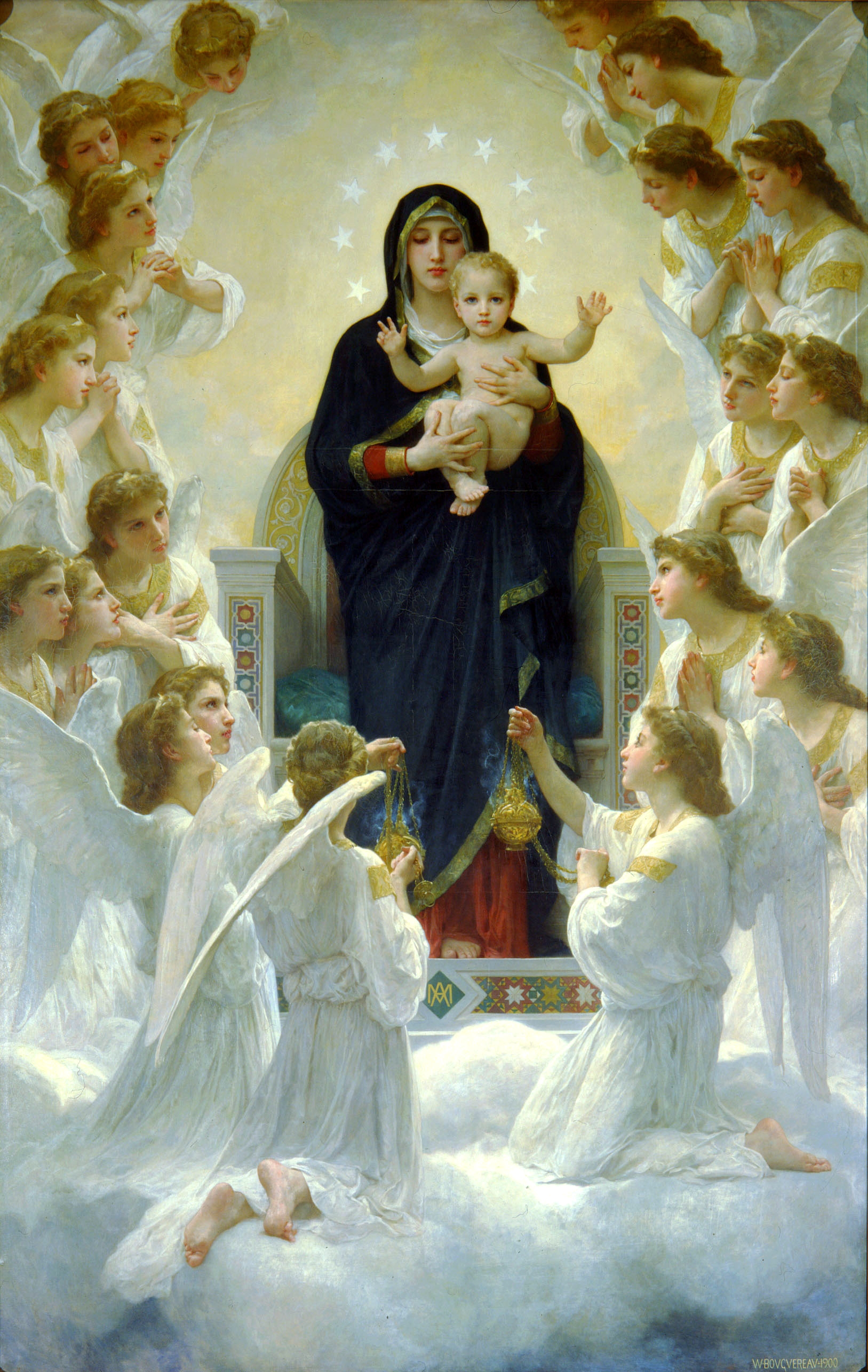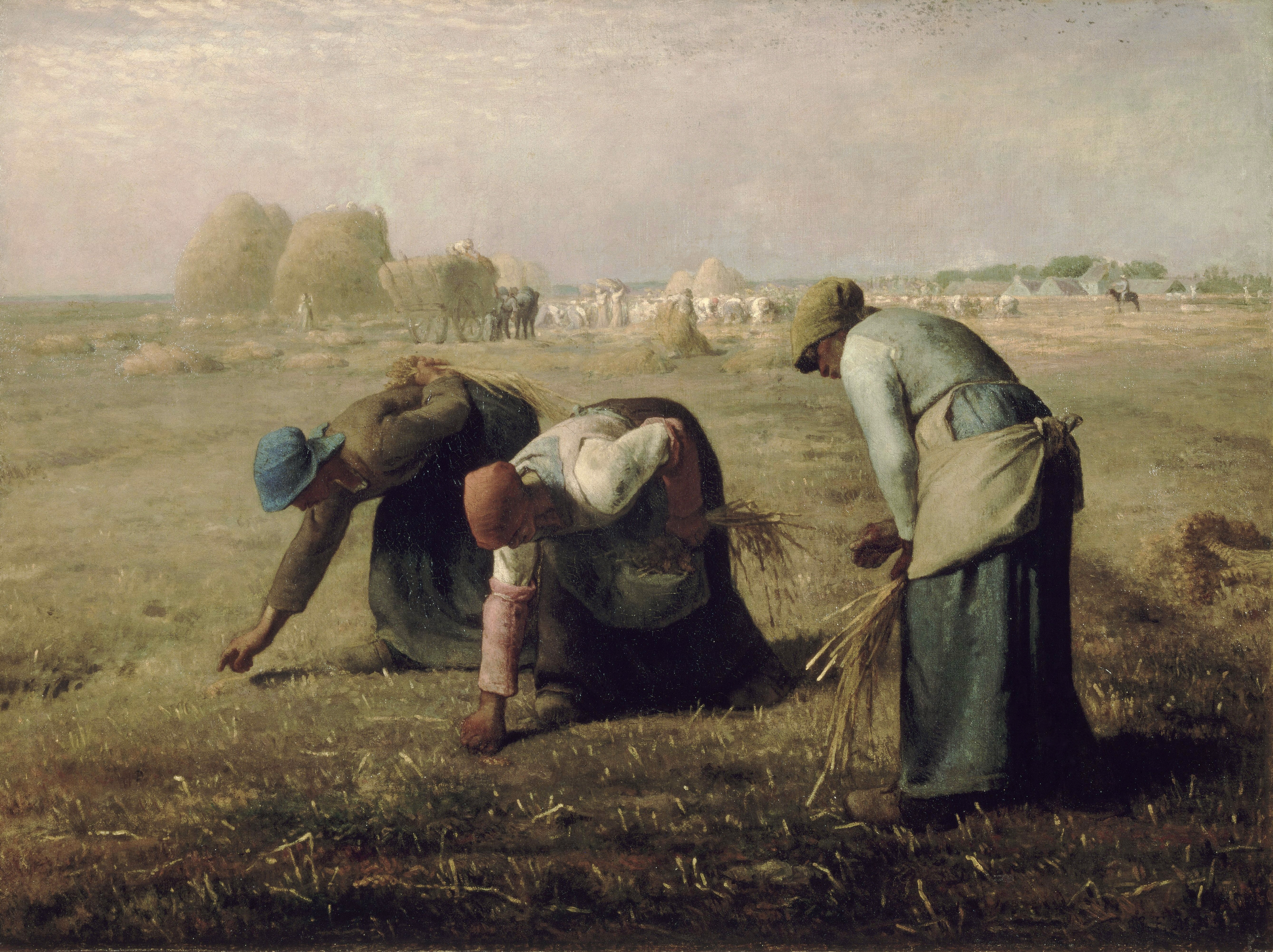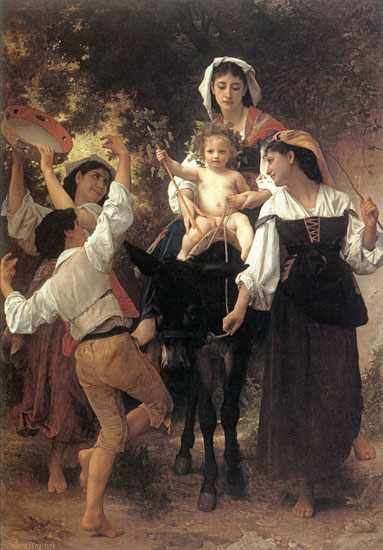William Adolphe Bouguereau (1825-1905) was a French Academic painter who was a prominent figure in the Salon. He painted a lot of mythological, religious and allegorical pictures which was typical of academic painters of the time. The smooth, neoclassical finish of his paintings and his expert rendition of human flesh had earned him a lot of prizes in his lifetime - he obtained the first Grand Prix de Rome and a scholarship at the Villa de Medici in Rome in 1850, at just the age of 25. He was made Chevalier of the Legion of Honour in 1859 and a member of the Académie de Beaux-Arts and Officer of the Legion of Honour in 1876. He was also appointed a professor at the École de Beaux-Arts in 1888 and made Grand Officer of the Legion of Honor in 1902.
 |
The Virgin with Angels by William Adolphe Bouguereau (1825-1905)
oil on canvas, 1900 |
.jpg) |
The Birth of Venus by William Adolphe Bouguereau (1825-1905)
oil on canvas, 1879 |
_-_Portrait_de_Mademoiselle_Elizabeth_Gardner_(1879).jpg) |
Portrait of Elizabeth Jane Gardner by William Adolphe Bouguereau (1825-1905)
oil on canvas, 1879 |
Throughout Bouguereau's career, the world saw the greatest explosion of styles, subjects and experimentation in all of art history including expansion and development both technically and thematically that had ever occurred before since the Enlightenment. The great Academic painters of the 19th century (Cabanel, Gérôme, Alma-Tadema, etc.) were all pushed aside by the new Modernist theory. Bouguereau's painting style and subject matter was everything the Impressionists and Realists loathed. His name became somewhat of a joke, as Degas and his Impressionist friends called very smoothly finished academic paintings "Bouguerated". Van Gogh also disliked Bouguereau. In a
letter he wrote to his brother Theo in August 1888 he said that "if we painted like Bouguereau people wouldn't be ashamed to let themselves be painted,
" and "if we painted like Bouguereau
, that we could then hope to earn."
It comes as no surprise that after Bouguereau's death in 1905, the popularity of his work suffered a steep decline due to the rise of the new Avant-Garde ideas and art movements in the early 20th century. His work was considered kitsch and untasteful, and only after the 1970s did it become 'acceptable' to appreciate his works once again.
One genre of painting that Bouguereau was praised for were paintings of peasants. During the aforementioned explosion of styles, subjects and experimentation was a rise of the genre of peasant paintings and changes in attitudes towards them. At first, they were simple, idyllic pictures with strong religious or moral undertones, but the French Revolution of 1848 brought about a change in how people treated peasants and how they were represented in art.
 |
The Milkmaid by Greuze (1725-1805)
oil on canvas, 1780-4? |
 |
The Shepherdess by Jean-Honoré Fragonard (1732-1806)
oil on canvas, ca. 1750-2 |
Artists like Millet, Bastien-Lepage and Courbet painted peasants as realistically as possible, warts and all. Many paintings representative of rural life were painted without idyllic and pastoral associations as paintings of peasants became more relevant to modern life.
 |
October by Jules Bastien-Lepage (1848-1884)
oil on canvas, 1878 |
 |
The Gleaners by Jean-François Millet (1814-1875)
oil on canvas, 1857 |
 |
The Stone Breakers by Gustave Courbet (1819-1877)
oil on canvas, 1849 |
Although a lot of artists preferred to depict the gritty reality of rural life, grand paintings of mythological and historical scenes were still more popular in the Salon. As time went on however, more academic painters had started to depict peasants and the countryside in their art. What begun as a resistance against the Academic style was now a popular and socially acceptable genre. The characteristics of rural life that been thought of expressions of the peasants' victimization were now gone and transformed into civic qualities which was hoped that the urban poor would emulate.
 |
Rest by William Adolphe Bouguereau (1825-1905)
oil on canvas, 1879 |
 |
A Fisherman's Daughter by Jules Breton (1827-1906)
oil on canvas, 1878 |
Thus, the appearance of the peasant in artworks by Academic painters changes yet again. For example,
Rest by Bouguereau and
A Fisherman's Daughter by Jules Breton are complete opposites to the works of Courbet who made an effort to duplicate the hard life of the peasant on the canvas.
On the ArtRenewalCenter website, in an entry for
Rest, Kara Ross writes;
"Though the family depicted in this scene is poor, one can tell that they understand that money does not necessarily buy happiness. The mother tenderly holds her baby with her older son asleep at her feet indicating the joy and peace that can be found in everyday family life and in motherhood. The mother gazes out at her viewers as if to ask how she could possibly need more then she already has, her greatest treasures lying in her arms and at her feet. Bouguereau was a deeply religious man, and the church in the background symbolizes that God rules over the rich as well as the poor, and that all people are children of God and equal in His eyes."
This interpretation of the painting is correct to a certain point, however it completely ignores the fact that the image Bouguereau has produced is an idealized version of the real-life peasant which has sugar-coated the aspects of being a part of the working class.
"Money does not necessarily buy happiness": Indeed it may not, but it does buy necessary things one may need to survive and have a comfortable life which can contribute to happiness.
 |
The Shepherdess by William Adolphe Bouguereau (1825-1905)
oil on canvas, 1889 |
The Shepherdess by Bouguereau is also a very idealized image of the peasant. The painting depicts a young girl with dark hair in front of a vast landscape, with grazing cattle in a field behind her. It has a peaceful, idyllic atmosphere. She has good posture which makes her look confident, and the hilly landscape behind her and the raised foreground makes it look like she is looking down on the viewer.
Children were a favourite of Bouguereau's to paint. He had young girls from Brittany pose for him in his garden in La Rochelle, calling those paintings either "Little Shepherdess", or "Little Beggar" - whatever he felt like at the time and what kind of a 'vibe' he was getting from the sitter.
Although these 'shepherdesses' and 'beggars' were dressed in simple peasant clothes and didn't wear any shoes, as Louis Sonolet wrote, "they have the hands and feet of Duchesses", which rings true as the skin of the peasants in Bouguereau's painting look too pure, their feet too clean, their hands too smooth, their faces young and free of any signs of a hard life, and their clothes look too fresh, as if they are being worn for the first time. Sonolet also stated that Bouguereau "Never tried either exactly to represent the characters before him or to reproduce the types of a certain class. He made for himself an abstract image of beautiful forms, completely independent, so to speak, of anything that could affect or modify it. In his way of rendering nature a considerable part of it is purely subjective. He never stops with things exactly as they are. He cannot help idealizing all the touches." Bouguereau indeed could not help 'idealizing all the touches', as in an article by Eugene Tardieu he said that "in painting, I am an idealist. I only see the beautiful in art and, for me, art is the beautiful. Why reproduce the ugly things that exist in nature? I see absolutely no need for it, unless it can be done by someone who is immensely talented."
Anyhow, many painters chose children as their subjects, skirting social issues and sugar-coating the hardships of rural life. By choosing children to be the protagonists of their paintings made the works more acceptable to be hung in the homes of the middle and upper classes, as the vulnerable and charming little kids made no overt demands for help and sweeping political reform. These kinds of pictures fit into the sentimental and anecdotal taste of the period.
Shepherds and shepherdesses were also popular subject matters, it’s said that they were regarded as more respectable members of the society. Certain shepherds acquired some sort of a heroic status and had an aura of respectability about them.
 |
The Little Beggar by William Adolphe Bouguereau (1825-1905)
oil on canvas, 1880 |
A lot of academic artists who painted peasants painted unrealistic representations of rural life. They were biased by many preconceived ideas derived from their social background, training and what was popular with the critics and patrons. These paintings were painted by the upper classes, for the upper classes. They didn’t want a dirty peasant cowering in a field; they wanted a beautiful woman standing in a field, much like paintings from past centuries where French aristocrats were seen play-acting at being shepherds or their mistresses “merry-making” as milkmaids. The artist was chasing the peasant but couldn’t catch them, instead he got his shadow.
 |
The Dancing Milk Maids by Francis Hayman (1708-1776)
oil on canvas, ca.1735 |
 |
The Harvester by William Adolphe Bouguereau (1825-1905)
oil on canvas, 1868 |
Being from a wealthier background, artists were also able to travel around the world to seek inspiration. As mentioned earlier, Bouguereau was awarded a scholarship in Villa de Medici and the Grand Prix de Rome in 1850- meaning he studied in Italy and undertook a grand tour of Europe. In consequence it is very possible that the rural life of Italy also influenced his work, as he would’ve often made studies from life based on local peasant models.
Italy reminded the French of the classical world, so over the course of the century all manner of Italian costumes and customs also were presented to the public. For example, Bouguereau’s painting
Return from the Harvest painted in 1879 has a very religious and mythological feeling to it and is the most inaccurate representation of rural life possible, as there was no French equivalent to the Italian south. These kinds of paintings are very similar to ones in the style of Orientalism, but can also represent artistic escape.
 |
Return from the Harvest by William Adolphe Bouguereau (1825-1905)
oil on canvas, 1878 |
Linda Nochlin writes that the representation of labour in art had become “feminized” during that time, as there was a lack of ploughmen, sowers and stonebreakers.
On one hand, the peasant became a modern goddess. More specifically, the Goddess of the harvest, Ceres. There was no sense of contemporaneity that was associated with early Realism. Paintings no longer showed the peasants as suffering victims of exploitation.
On the other hand, the female peasant became a political symbol. Painters painted a lot of milkmaids and shepherdesses, and Nochlin stated that those kinds of paintings represented the “ideological definitions of femininity” and “the good worker”. The feminized peasant paintings acted as a sister to alternative images of the country, like Liberty, in Delacroix's Liberty Leading the People. They were symbols of calm, productive labour and imagined rural stability. She, like the late Realist peasant woman, successfully encased political modernity within a cloak of “traditional values”.
 |
Liberty Leading the People by Eugène Delacroix
oil on canvas, 1830 |
The implied imagery of the working peasant in the role of a powerful figure could also serve as something that could empower the lower classes, however you cannot deny that Bouguereau's prerogative to sugar coat the reality of peasant life, alongside many other artists who idealized French rural life, played a bigger part in the erasure of the hardships of the lower classes and reinforcement in the upper classes of the idea that the lower classes are happy with being poor, thus releasing them of any guilt that they might be a part of a system that victimizes the poor.
Sources
Tuffelli, N., 19th Century French Art: 1848-1905, Edinburgh: Chambers Harrap Publishers, 2004
Glueck, G., "Art View: To Bouguereau, Art was Strictly the Beautiful", New York Times, 6 January 1985
"Bouguereau and the Real 19th Century"
https://www.artrenewal.org/articles/Philosophy/TheReal19thCentury/thereal19thcentury.php
http://www.vangoghletters.org/vg/search/simple?term=bouguereau
Bezucha, R. J., "The Urban Image of the Countryside in the Late 19th Century French Painting; And Essay on Art and Political Culture", in Sturges, H,, The Rural Vision: French and America in the Late 19th Century, Nebraska: Nebraska Press, 1982, pp. 13-21
"William Bouguereau - an Introduction by Fred Ross"
https://www.artrenewal.org/articles/2010/BouguereauIntroduction/BouguereauIntroduction.php
The French Peasant in French 19th Century Art, Exhibition Catalogue by Thompson, J., Dublin, Trinity College, 1980
Author Unknown, Bouguereau: French School, Boston: Bates and Guild, 1906, p. 416
"Bouguereau at Work"
https://www.artrenewal.org/articles/Technical_Articles/WALKER-BOUGUEREAU/WALKER-BOUGUEREAUpage1.php
















.jpg)
_-_Portrait_de_Mademoiselle_Elizabeth_Gardner_(1879).jpg)











